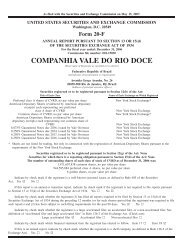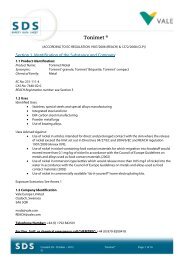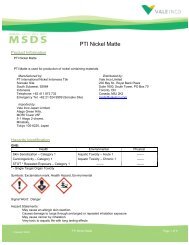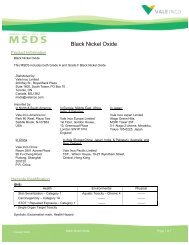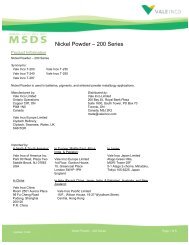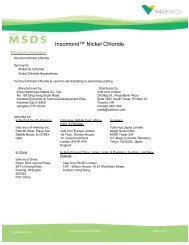Plating Chips - Vale.com
Plating Chips - Vale.com
Plating Chips - Vale.com
Create successful ePaper yourself
Turn your PDF publications into a flip-book with our unique Google optimized e-Paper software.
<strong>Plating</strong> <strong>Chips</strong><br />
Hazardous Ingredients<br />
Hazardous Ingredients Calculated Composition C.A.S. No<br />
Exposure Limit<br />
(PEL) 1 – mg/m 3<br />
Exposure Limit<br />
(TLV) 2 –mg/m3<br />
Nickel (Ni) 99.97 7440-02-0 1 1.5*<br />
*as inhalable fraction<br />
Physical and Chemical Data<br />
Silver-grey, odourless metal chips of approximately 4-8 mm thick and >15 mm in diameter, packaged density 4.5 – 6.0<br />
g/cm 3 .<br />
Melting Point Boiling Solubility in water<br />
Ingredient Mol. Wt. Specific Gravity<br />
(°C) Point (°C)<br />
(g/100ml)<br />
Ni 58.71 8.9 1453 2732 0<br />
Physical Hazards<br />
Material can create slippery conditions if spilled.<br />
Health Hazards<br />
Nickel<br />
Acute Toxicity:<br />
a) Oral: Non toxic - LD 50 ORAL RAT >9000 mg/kg<br />
b) Inhalation: No information available<br />
c) Dermal: No information available.<br />
Corrosivity/Irritation:<br />
a) Respiratory Tract: None<br />
b) Skin: See sensitization section.<br />
c) Eyes: Mechanical irritation may be expected.<br />
Sensitization:<br />
a) Respiratory tract: Nickel metal induced asthma is very rare. 3 case reports are available; the data is not<br />
sufficient to conclude that nickel metal is classified as a respiratory sensitizer.<br />
b) Skin: Nickel metal is a well-known skin sensitizer. Direct and prolonged skin contact with<br />
metallic nickel may induce nickel allergy and elicit nickel allergic skin reactions in those<br />
people already sensitized to nickel, so called nickel allergic contact dermatitis.<br />
c) Pre-existing conditions: Individuals known to be allergic to nickel should avoid contact with nickel whenever<br />
possible to reduce the likelihood of nickel allergic contact dermatitis reactions (skin<br />
rashes). Repeated contact may result in persistent chronic palmar/hand dermatitis in a<br />
smaller number of individuals, despite efforts to reduce or avoid nickel exposure.<br />
Chronic toxicity:<br />
a) Oral: No information available<br />
Updated: 11/09<br />
<strong>Plating</strong> <strong>Chips</strong> Page 1 of 3
) Inhalation: Animal studies (rats) show that repeated dose inhalation of nickel damages the lung.<br />
Chronic inflammation, lung fibrosis and accumulation of nickel particles were observed.<br />
c) Dermal: Direct and prolonged skin contact with nickel metal may cause nickel sensitization<br />
resulting in nickel allergic contact dermatitis /skin rash.<br />
Mutagenicity /<br />
Reproductive toxicity:<br />
No data.<br />
Carcinogenicity:<br />
a) Ingestion: The U.S. National Institute for Occupational Safety and Health (NIOSH) concluded that<br />
there is no evidence that nickel metal is carcinogenic when ingested.<br />
b) Inhalation: There is limited information available from inhalation and intratracheal studies in animals.<br />
The U.S. National Toxicology Program has listed metallic nickel as reasonably<br />
anticipated to be a human carcinogen. To date, there is no evidence that nickel metal<br />
causes cancer in humans based on epidemiology data from workers in the nickel<br />
producing and nickel consuming industries.<br />
The International Agency for Research on Cancer (IARC)(Vol 49) found there was inadequate evidence that<br />
metallic nickel is carcinogenic to humans but since there was sufficient evidence that it is carcinogenic to animals,<br />
IARC concluded that metallic nickel is possibly carcinogenic to humans (Group 2B). In 1997, the ACGIH<br />
categorized elemental nickel as: A5 "Not Suspected as a Human Carcinogen". Epidemiological studies of<br />
workers exposed to nickel powder and to dust and fume generated in the production of nickel alloys and of<br />
stainless steel have not indicated the presence of a significant respiratory cancer hazard.<br />
Precautions for safe storage, handling and use<br />
If user operations generate dust, fume or mist, use ventilation to keep exposure to airborne nickel below the PEL. If ventilation<br />
alone cannot so control exposure, use NIOSH-approved respirators selected according to OSHA 29 CFR 1910.134. Maintain<br />
airborne nickel levels as low as possible.<br />
Avoid repeated skin contact. Wear suitable gloves. Wash skin thoroughly after handling. Launder clothing and gloves as<br />
needed.<br />
Do not store near acids. Like other metals, nickel can react with acids to liberate hydrogen gas which can form explosive<br />
mixtures in air.<br />
Under special conditions nickel can react with carbon monoxide in reducing atmospheres to form nickel carbonyl, Ni(CO) 4 ,<br />
a toxic gas.<br />
Spill, leak and disposal procedure<br />
Pick up product and replace in original container. Nickel-containing waste is normally collected to recover nickel values.<br />
Should waste disposal be deemed necessary, follow EPA and local regulations.<br />
Emergency and first aid procedures<br />
If exposure to nickel carbonyl is suspected, seek medical attention immediately. For skin rashes, seek medical attention.<br />
Cleanse wounds thoroughly to remove any particles.<br />
Updated: 11/09<br />
<strong>Plating</strong> <strong>Chips</strong> Page 2 of 3
SARA Section 313 Supplier Notification<br />
This product contains the following chemical(s) subject to the reporting requirements of Section 313 of the Emergency<br />
Planning and Community Right-to-Know Act of 1986 and of 40 CFR 372:<br />
Nickel<br />
Refer to the Hazardous Ingredients section of this MSDS for the appropriate CAS numbers and percent by weight.<br />
<strong>Vale</strong> Inco America Inc.<br />
Park 80 West, Plaza Two<br />
Saddle Brook, NJ 07663<br />
Chemtrec 24 hr Emergency No. 1-800-424-9300<br />
Preparation Information<br />
Prepared by:<br />
<strong>Vale</strong> Inco Limited<br />
200 Bay St., Royal Bank Plaza<br />
Suite 1600, South Tower, PO Box 70<br />
Toronto, Ontario, Canada, M5J 2K2<br />
Product Stewardship (416) 361-7801<br />
MSDS available online at www.valeinco.<strong>com</strong><br />
msds@valeinco.<strong>com</strong><br />
Note:<br />
<strong>Vale</strong> Inco believes that the information in this Material Safety Data Sheet is accurate. However, <strong>Vale</strong> Inco makes no express or<br />
implied warranty as to the accuracy of such information and expressly disclaims any liability resulting from reliance on such<br />
information.<br />
Footnotes:<br />
1 OSHA Permissible Exposure Limit.<br />
2 Threshold Limit Value of the American Conference of Governmental Industrial Hygienists.<br />
Updated: 11/09<br />
<strong>Plating</strong> <strong>Chips</strong> Page 3 of 3



